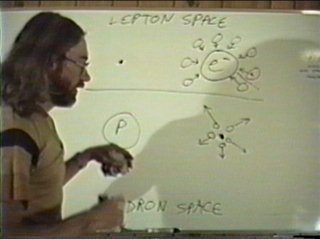
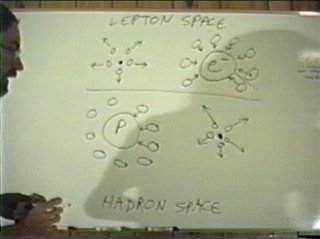
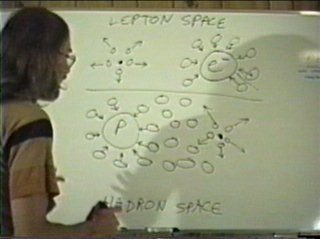
   |
A quark is a collision cell of nuclear strings. The quark is like a big fat quanta that conserves three or more fundamental units of volume, it has some exotic properties. For one thing, it has to keep track of the energy and volume of three or more quanta mixing phases in it at different angles. That's a heck of a lot to keep track of with the simple forms the geometry has been developing up to now. Now, as a big fat quanta with a heck of a lot to keep track of, and a lot of energy, a depleted quanta may see it as something it can mix phases with. The quark disagrees, says "I got my hands full already, and I got more energy then I can find a place to put it. Here," says the quark, "take this and get away from me." The quark does mix phases briefly with the depleted quanta, long enough to shove it away. The process of shoving it away involves flipping both the internal arrows, momentum and angular momentum, and rotating it into the other domain. Actually, it could only flip one arrow and be forced to rotate the quanta's dimensions to prevent a violation in conservation of angular momentum... it depends on how the universe translates energy between domains. For example, is a right-handed hadron left-handed in lepton space? I don't know. Somehow, the quanta is translated between lepton space and hadron space, and it receives an energy boost from the quark in the process. The direction of the translation (lepton --> hadron) or (lepton <-- hadron) determines the polarity of the charge force. The charge force has a long range attraction between oppositely charged particles, as each particle drags space-time towards it from one domain and sources it in the opposite domain. As the opposite charges draw closer together, they start repelling each other, because the quanta they are kicking off start hitting the other particle directly, delivering their energy to each other via the charge couriers. There is nothing "virtual" about these depleted quanta, they are the fabric of space-time. So, the charge force has a long range and short range component, and it is a process of translating energy between the two domains of space-time. In this regard, the surface of a quark is like a magic mirror, or perhaps, a doorway. |
Charge is a cosmlogical force, it is the new energy the parent universe has dumped into the daughter universe implementing itself into the manifold by redistributing the pre-existing temporal strings of the manifold. Charge delivers the energy to the pre-existing strings, causing their volume to diminish a bit, and the energy-density of space-time to increase. The charged particles in the universe are temporal conduits which carry new energy through time. The apparent expansion of the universe is due to the depletion of the energy which constitutes space. The galaxies are relatively stationary, but the volume of space keeps increasing between them, representing the depletion of energy over time. Since nuclei steal energy by radiating gravitons, their size remains fixed by their minimum energy content, but those gravitons may interact with space, cancelling energy and increasing spatial volume. *The universe expands because of gravity. The nucleus writes a check, space has to cash it. Less energy = more volume. If not for the cancelling affect of gravity, I submit that the universe would never expand. Because gravity causes the expansion, I submit the expansion will go on forever, the universe can not re-collapse, not under the force of gravity. Makes no difference how much "missing mass" you find, gravity doesn't work that way on the dimensions (i.e. volume) of space-time.
* 2008 NOTE: Actually, I knew charge was using energy and causing angular momentum in the universe to run down in 1994, but I wasn't certain where or how that energy was being expended. I knew that from a cosmological perspective the energy was being used to redistribute temporal strings and reduce their volume via charge interactions, but the exact nature of the loss of angular momentum had not occurred to me yet, so I sidestepped the issue. I realize now that every interaction with couriers of the charge force includes a small loss of angular momentum to recoil effects, and the recoil effects translate into thermal kinetic energy. In 1994 I assumed the exchange of angular momentum in interactions involving charge and gravity were 100% efficient. However that assumption leads to a universe that does not expand.
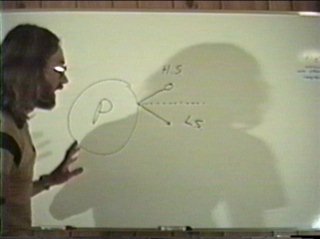
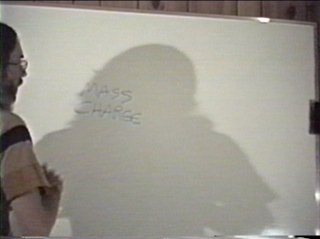 |